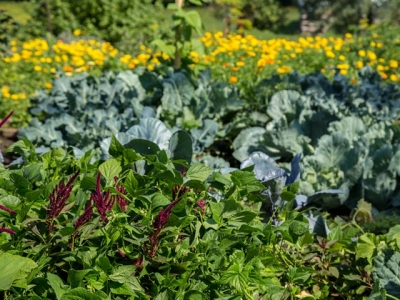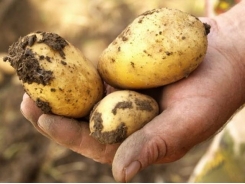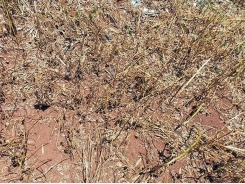10 Smart Ways to Garden on the Cheap

You don’t have to spend obscene amounts of money to grow your own food. Here are some tips for a spectacular backyard garden without the exorbitant expenses. Photo: By lavizzara on Shutterstock
1. Grow from Seeds, Not Starts
A six-pack of lettuce seedlings costs anywhere from $3 to $6, while a pack of 500 lettuce seeds costs no more than $3. There’s no reason to be intimidated: it’s a bit more work to start seeds in flats indoors, which gives you a head start on the growing season, but sowing seeds directly in the garden bed takes no more time than planting seedlings.
2. Go to a Seed Swap
Shopping for seeds is fun, and you can find some real bargains if you’re scrupulous enough. But going to a seed swap a party where everyone shows up ready to trade seeds they’ve saved from the year before is arguably even more fun and will save you money, too. Which brings about another point—save your seeds in the fall! As long as they’re not patented, saving seed doesn’t cost a thing.
3. Take Cuttings
You’re probably thinking: saving seed is fine for vegetables, but who really grows blueberries or dogwood trees from seed? That’s true. Lots of things are hard to grow from seed, or don’t grow “true” from seed because they are propagated asexually (meaning they’re genetic clones). The good news is virtually all perennials, most shrubs and vines, and many trees are easily propagated by cuttings. Find a neighbor or a friend with the desired plant, cut off a few pencil-size sticks, pot them up in moist perlite, and within a few weeks or months, depending on the plant, you should start to see roots and leaves emerging.
4. Repurpose and Upcycle
Plants are costly enough, but planters, pavers, arbors, and other hardscape materials are where the budget quickly enters the four-figure range. But one man’s junk pile is another man’s goldmine, right? Planters can be fashioned out of everything from an old bathtub to used wooden pallets. I’ve seen arbors made from a repurposed satellite dish mounted on a pole and trellises built from ancient bedsprings. Instead of expensive flagstone, try broken concrete some people lovingly refer to it as urbanite and dye the surface for a more attractive finish. But exercise restraint: When you go overboard, upcycling can make you feel like you have a yard full of junk.
5. Forage for Your Gardening Supplies
Nature also offers free materials to help you get the most mileage from your gardening dollar. Bamboo poles at a garden center, which are used for everything from tomato stakes to building beautiful oriental fences and arbors, run from $1 to $10 (or more) a piece, depending on the size. But lots of folks have a yard full of bamboo and would be happy for you to come take some of it off their hands. There are many other examples like this any time you think, oh I wish I had the money to buy that for the garden, rack your brain for a free, locally harvestable alternative.
6. Design It Yourself
Professional garden design can run several thousand dollars, even for a small yard. There are reasons for that (i.e. years of training and experience), but with a bit of patient effort you’ll be surprised at what you can come up with. Start at the library, where there are volumes upon volumes of garden design books and references that will tell you exactly what conditions are preferred by every plant in the known universe and how to build patios, fences, raised beds, gazebos, waterfalls, and anything else you can dream up. Then map out your yard on paper, as accurately as you can, and start penciling in ideas. Give yourself a full year to come up with a design, making careful observations through the seasons and taking the time to visualize your ideas in detail before you start building.
7. Make Your Own Soil Amendments
Buying bags of compost and all-natural fertilizers can really add up, but if you think about what is actually in those products mostly animal by-products (like bat guano, feather meal, and bone meal) and various forms of organic matter (shredded bark, coco husks, etc) it seems a pity to pay. If you don’t have your own chickens or other livestock as a manure source, you can certainly find a friend or local farmer who will let you clean out their barn. Mix the manure with wood shavings, grass clippings, leaves any form of organic matter you can get your hands on will do and then pile it up and let it stew for a few months into a rich black compost. For extra nutrients, save your eggshells and crush them into the compost (adds calcium and phosphorus) and, if you live near the beach, harvest some seaweed for a boost of micronutrients just be sure to rinse the seaweed thoroughly in fresh water to get rid of the salt.
8. Avail Yourself to Free Compost and Mulch
Tree-cutting companies often have big piles of mulch on hand that they give away for free. And many municipalities convert their citizens’ green waste into compost and mulch, which they then give away for free at the landfill or sell for a nominal cost. These freebies aren’t always the greatest quality they may contain shredded trash or seeds of invasive species, for example so use at your own risk.
9. Become a “Free List” Specialist
Craigslist has a “Free Stuff” section that is often a goldmine for everything from live plants to pots to piles of compost, and many other classified services have their own “Free Lists” or barter sections. Many communities have a local “Buy Nothing” Facebook group, or a neighborhood-centric “virtual garage sale” where most items are priced-to-move. Beyond total freebies, scouring flea markets and garage sales is a great way to find gently used gardening tools at a fraction of the cost of buying them new.
10. Grow Organic
Sticking with all-natural methods does have its financial benefits. Chemical pesticides always cost money, for example, but attracting beneficial insects to the garden (good bugs that eat the bad bugs) is surprisingly easy and totally free. Same with herbicides: You can manually remove pesky weeds, smother them to death under black plastic or layers of cardboard and woodchips, or even borrow a couple of goats to munch through particularly heavy vegetation (they love eating things like kudzu, poison ivy and thorny briars). In addition to composting, you can use living plants, called cover crops, to return nutrients to your soil the all-natural, and inexpensive, way.
Related news
Tools

Phối trộn thức ăn chăn nuôi

Pha dung dịch thủy canh

Định mức cho tôm ăn

Phối trộn phân bón NPK

Xác định tỷ lệ tôm sống

Chuyển đổi đơn vị phân bón

Xác định công suất sục khí

Chuyển đổi đơn vị tôm

Tính diện tích nhà kính

Tính thể tích ao




 What Does a Seed Farmer Do?
What Does a Seed Farmer Do?  How to control cucurbit viruses
How to control cucurbit viruses